To master white bass fishing, we’ll need to target these aggressive schoolers during their spring spawning runs in tributaries when water temps hit 50-60°F. Use medium-action rods with 8-10 lb line and focus on finding schools with a fish finder. Small spinners, jigs with curly tails, and live minnows work wonders depending on water clarity. When you hook one fish, stay put—where there’s one, there’s usually many more waiting below.
White Bass Identification and Natural Habitat
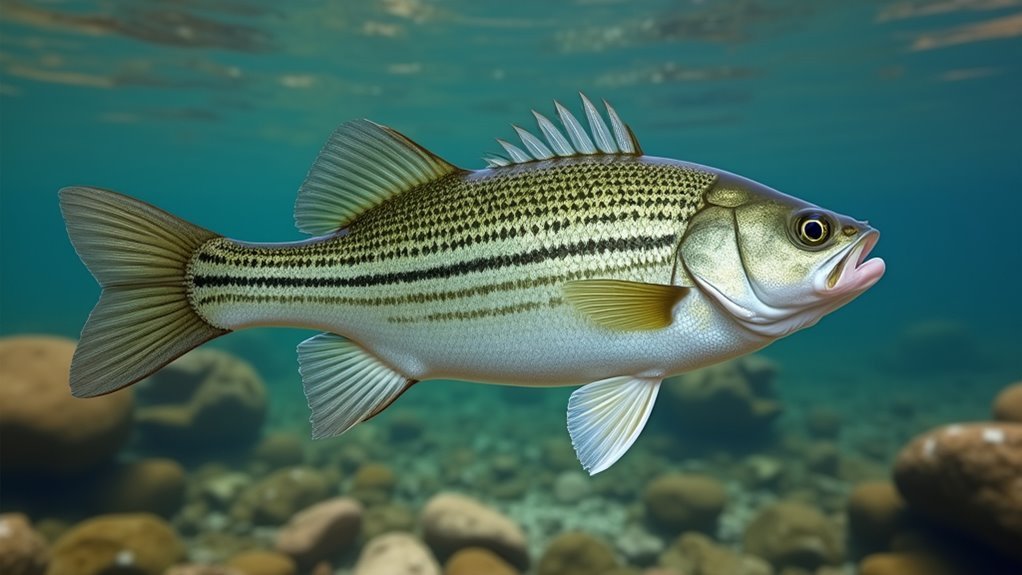
When you’re out on the water hunting for white bass, knowing what you’re looking for is half the battle. These freshwater beauties (Morone Chrysops) look similar to striped bass and thrive in the Midwest, particularly in the Mississippi and Ohio River systems.
We’ve found white bass prefer areas with moderate current—they’re not fans of stagnant water. Look for them in open waters, tributaries, and around structures like bridges and rocky areas. They love feeding on the surface!
During our spring outings, we’ve had great luck targeting creek mouths where they flow into larger lakes. That’s when these schooling fish are most active and enthusiastic to bite.
Seasonal Fishing Patterns: When and Where to Find White Bass
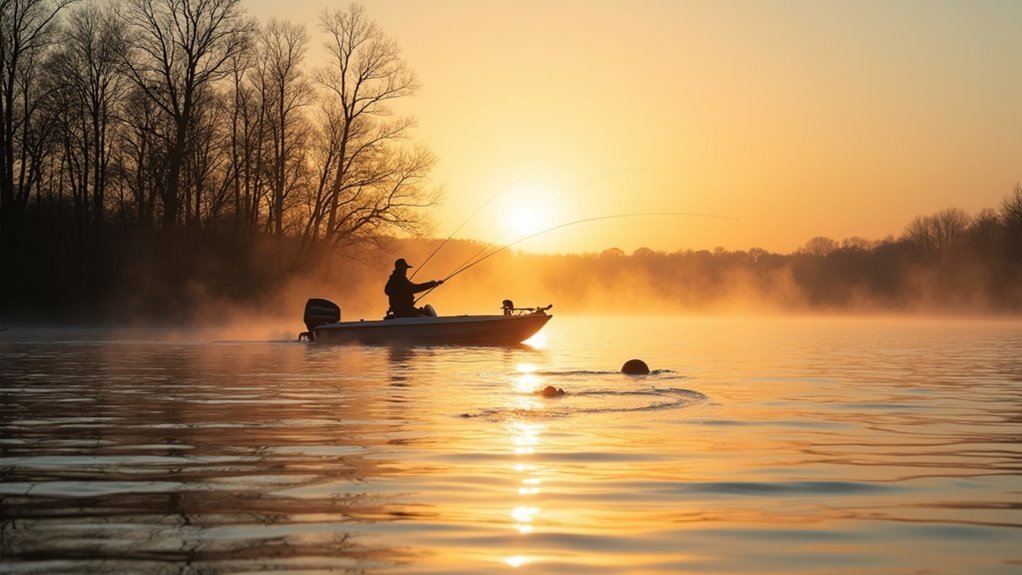
Throughout the year, white bass behavior shifts dramatically with the changing seasons, making timing essential for successful fishing trips. We’ve found spring to be prime time, when water hits that sweet spot between 50-60°F. They’re making spawning runs up tributaries, and man, the action can be incredible!
In summer, they retreat to deeper, cooler waters. We once filled a cooler during a sunrise feeding frenzy on Lake Erie. Fall finds them back in tributaries, while winter requires patience around deep structures.
Whatever the season, a good fish finder is your best friend for locating those schooling fighters. Understanding thrust requirements can also improve your trolling motor’s effectiveness, ensuring you can navigate to those prime fishing spots efficiently.
Essential Tackle and Equipment for White Bass Anglers
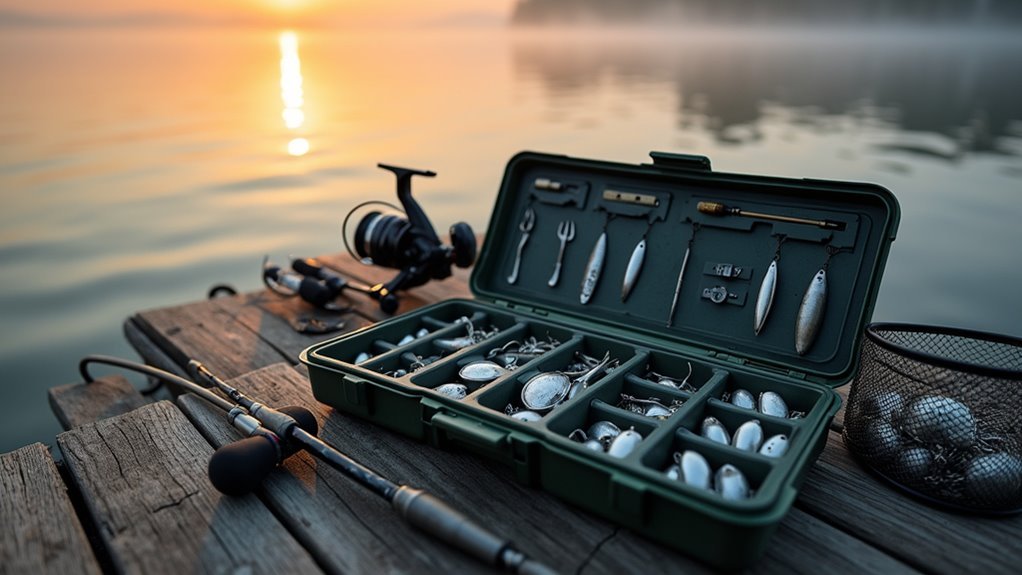
The right gear makes all the difference between a frustrating day and a cooler full of white bass. We’ve learned this lesson the hard way over years on the water. Keep it simple but effective!
| Equipment | Recommendation | Why It Works |
|---|---|---|
| Rod | Medium-action, 6-7 ft | Controls fish in current |
| Reel | Spinning, 2000-3000 size | Handles small lures well |
| Line | 8-10 lb monofilament | Ideal visibility and stretch |
| Lures | Small spoons, spinners | Mimics baitfish effectively |
| Extras | Fish finder, landing net | Locates schools, secures catch |
Remember to pack light – you’ll likely be moving frequently to follow these schooling fighters.
Proven Techniques for Targeting Schools of White Bass
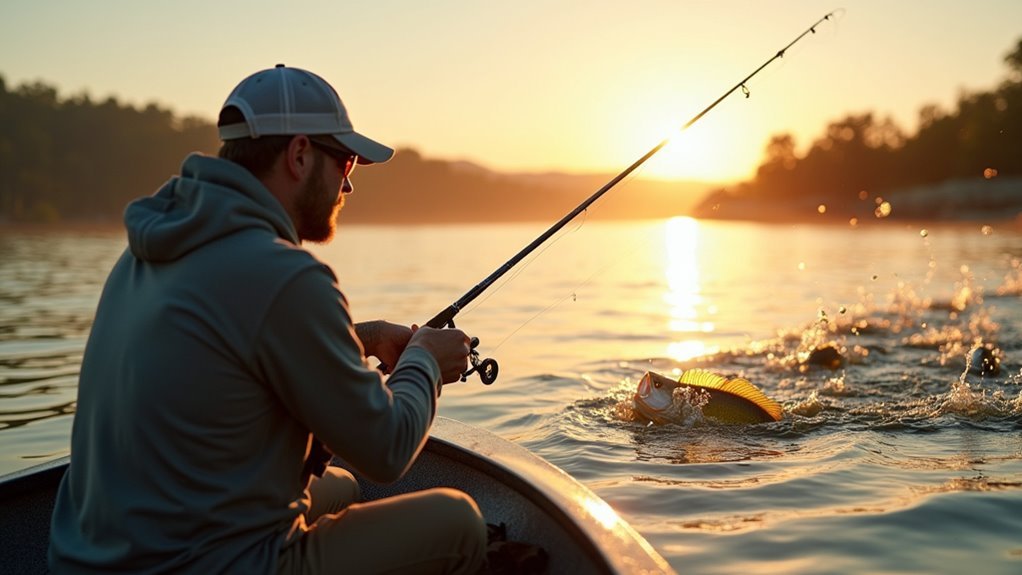
Successful white bass anglers share one critical skill—the ability to locate and stay with schools of feeding fish. We’ve found that tracking upstream movement is key, especially during spring when they congregate at lake mouths and tributaries.
Look for feeding frenzies on the surface—that’s your jackpot! We once spotted birds diving near a bridge and landed over 30 bass in an hour.
Vertical jigging works wonders in deeper waters (11-15 feet), while small spoons and spinners excel in open water. Remember, these fighters travel in packs, so when you hook one, more are nearby!
Top Baits and Lures That White Bass Can’t Resist
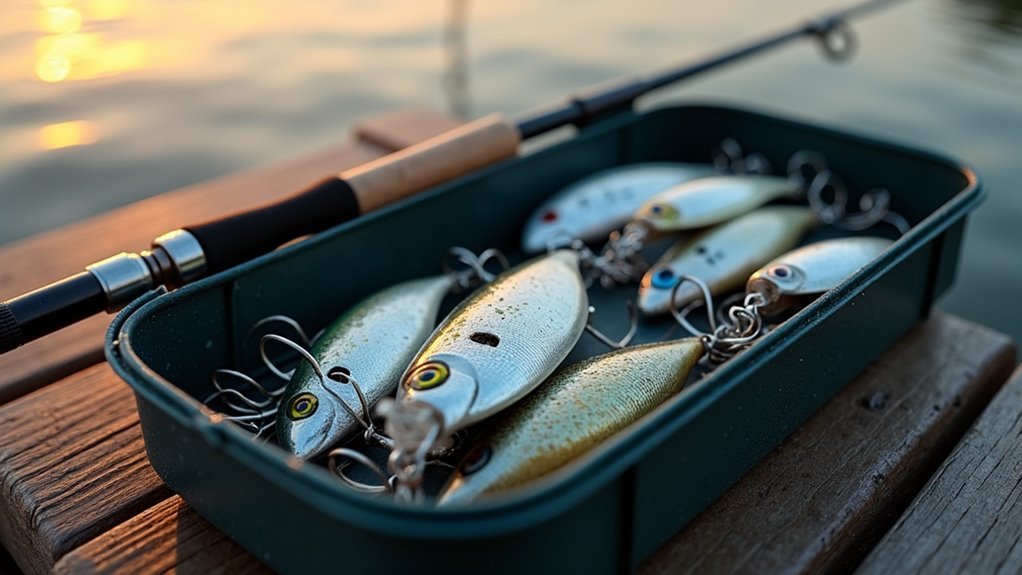
Few decisions impact your white bass success more than choosing the right bait or lure. We’ve spent countless hours testing what truly works for these aggressive feeders.
| Bait Type | Water Clarity | Season | Strike Factor |
|---|---|---|---|
| Live Minnows | All | Year-round | Irresistible |
| Shad | Clear/Murky | Spring/Summer | Natural Trigger |
| Spinners | Murky | Spring | Flash Masters |
| Jigs w/Curly Tails | Clear | Summer/Fall | Silent Killers |
Remember to match your presentation to conditions. In murky water, we’ve had lunkers crush bright-colored lures that would get ignored in clear conditions. Natural colors work wonders when visibility is high.
Record-Breaking Catches and Community Fishing Tips
While mastering techniques and selecting the right lures matters, nothing fires up anglers like chasing record-breaking catches. The biggest white bass on record sits at 6 lbs 13 ounces – a tie between Ronald Sprouse (1989) and Corey Crochet (2010). That’s quite a benchmark!
We’ve found that community wisdom often beats solo experimentation. Last spring, a fellow angler suggested we try bright chartreuse jigs during a murky water run. We landed eight hefty bass in an hour!
Don’t hesitate to share your successes and failures with other fishermen. We’re all in this together, and collective knowledge helps everyone land more fish. Additionally, understanding trolling motor positioning can enhance your fishing efficiency by allowing you to navigate effectively in varying conditions.
Frequently Asked Questions
Are White Bass Safe to Eat and Good Tasting?
Yes, we find white bass safe to eat and quite tasty! They’re a popular food fish with mild, flaky meat. We recommend removing the red stripe along the sides to avoid any “fishy” taste.
How Do White Bass Differ From Striped Bass When Fighting?
We feel white bass pull with quick, darting motions compared to striped bass’s powerful, sustained runs. They’re lighter fighters, lacking their cousin’s stamina, but their frantic zigzagging creates unique, energetic battles on lighter tackle.
Can White Bass Hybridize With Other Species?
Yes, white bass can hybridize with striped bass to create hybrids called “wipers” or “sunshine bass.” We’ll often find these intentionally stocked in lakes for their enhanced growth and fighting ability.
What’s the Typical Lifespan of a White Bass?
White bass have an incredibly short life! We’ve found they typically live just 4-7 years in the wild. They’re growing and reproducing quickly during this time, which explains their abundant populations in many waterways.
How Can I Distinguish Between Male and Female White Bass?
We can distinguish male and female white bass by size and body shape. Females are typically larger and have rounder bellies, while males tend to be smaller with more streamlined bodies.
Conclusion
White bass fishing isn’t just about catching fish—it’s about embracing the dance between angler and quarry. We’ve shared our time-tested secrets and hope you’re ready to hit the water. Remember, even when the bite seems as elusive as a ghost in the fog, patience and persistence pay off. Join the community, apply these techniques, and you’ll soon be reeling in white bass memories that’ll last a lifetime!